Viscosity and diffusion: crowding and salt effects in protein solutions
Abstract
We report on a joint experimental–theoretical study of collective diffusion in, and static shear viscosity of solutions of bovine serum albumin (BSA)

* Corresponding authors
a
Institute of Complex Systems (ICS-3), Forschungszentrum Jülich, Jülich, Germany
E-mail:
g.naegele@fz-juelich.de
b
Institut für Angewandte Physik, Universität Tübingen, Tübingen, Germany
E-mail:
frank.schreiber@uni-tuebingen.de
c Institute of Experimental Physics, Slovak Academy of Sciences, Košice, Slovakia
d Institut Laue-Langevin, Grenoble Cedex 9, France
e European Synchrotron Radiation Facility, Grenoble Cedex 9, France
f Department of Biochemistry, Faculty of Sciences, P. J. Šafárik University, Moyzesova 11, Košice, Slovakia
We report on a joint experimental–theoretical study of collective diffusion in, and static shear viscosity of solutions of bovine serum albumin (BSA)

 Please wait while we load your content...
Something went wrong. Try again?
Please wait while we load your content...
Something went wrong. Try again?
M. Heinen, F. Zanini, F. Roosen-Runge, D. Fedunová, F. Zhang, M. Hennig, T. Seydel, R. Schweins, M. Sztucki, M. Antalík, F. Schreiber and G. Nägele, Soft Matter, 2012, 8, 1404 DOI: 10.1039/C1SM06242E
To request permission to reproduce material from this article, please go to the Copyright Clearance Center request page.
If you are an author contributing to an RSC publication, you do not need to request permission provided correct acknowledgement is given.
If you are the author of this article, you do not need to request permission to reproduce figures and diagrams provided correct acknowledgement is given. If you want to reproduce the whole article in a third-party publication (excluding your thesis/dissertation for which permission is not required) please go to the Copyright Clearance Center request page.
Read more about how to correctly acknowledge RSC content.
 Fetching data from CrossRef.
Fetching data from CrossRef.
This may take some time to load.
Loading related content
